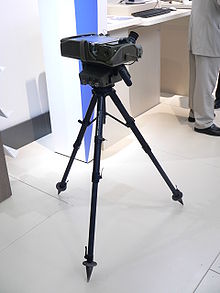
Back Lazer hədəf təyinedici Azerbaijani Apuntador làser Catalan Lasermarkierer German Designador láser Spanish لیزر نگارنده Persian Maalinosoituslaser Finnish Désignateur laser French ציין לייזר HE Penanda laser ID Designatore laser Italian
A laser designator is a laser light source which is used to designate a target. Laser designators provide targeting for laser-guided bombs, missiles, or precision artillery munitions, such as the Paveway series of bombs, AGM-114 Hellfire, or the M712 Copperhead round, respectively.
When a target is marked by a designator, the beam is invisible and does not shine continuously. Instead, a series of coded laser pulses, also called PRF codes (pulse repetition frequency), are fired at the target. These signals bounce off the target into the sky, where they are detected by the seeker on the laser-guided munition, which steers itself towards the centre of the reflected signal.[1] Unless the people being targeted possess laser detection equipment or can hear aircraft overhead, it is extremely difficult for them to determine whether they are being marked. Laser designators work best in clear atmospheric conditions. Cloud cover, rain or smoke can make reliable designation of targets difficult or impossible unless a simulation is accessible through available ground data.
- ^ U.S. Marine Corps (4 April 2018). "MCTP 3-10F Fire Support Coordination in the Ground Combat Element" (PDF). Marines.mil. pp. Appendix K. Archived from the original (PDF) on 16 July 2022. Retrieved 16 July 2022.
© MMXXIII Rich X Search. We shall prevail. All rights reserved. Rich X Search


